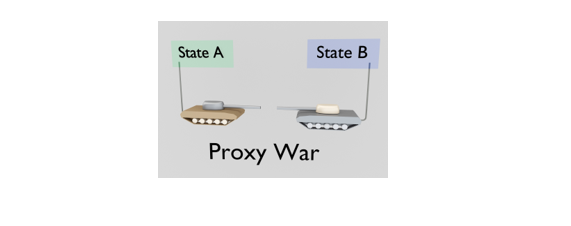DPhil candidate Giuseppe Spatafora summarises the key findings of the recently published Routledge Handbook of Proxy Wars, which aims to present the various facets of the phenomenon. The Handbook contains two contributions by DPIR scholars: one by Spatafora himself on the extent to which the Spanish Civil War presents proxy war characteristics, and one by Dr. Vanessa Meier on quantitative approaches to the study of proxy wars.
The phenomenon of proxy wars has existed for centuries, well before what is commonly perceived as its heyday—the Cold War. Albeit more modern, the study of proxy wars is not in its infancy either. The Routledge Handbook of Proxy Wars (2023), edited by Assaf Moghadam, Vladimir Rauta, and Michel Wyss, aims to illustrate this point by analysing proxy wars through historical, theoretical, and policy lenses. The Handbook is the first volume to comprehensively examine “the challenges, intricacies, and dynamics of proxy wars.” With 34 chapters, including two contributions by DPIR alumna Dr. Vanessa Meier and DPhil candidate Giuseppe Spatafora, it is poised to become the reference manual for the evolving field of proxy war studies.
The first thing that strikes the reader is that the Handbook does not begin with a clear definition of proxy war. This allows the editors too steer away from the simplistic and politicised use of the term—which tends to be used to downplay the role of local actors. Instead, the Handbook conceptualises proxy wars as a logic, as a relationship, and as a process. As a logic, proxy wars substitute the direct use of force, with an actor (principal or sponsor) entrusting another party (proxy/client) to fight on its behalf—essentially delegating the conflict—in exchange for material, diplomatic or other forms of support. As a relationship, proxy wars encompass the range of interactions between the sponsor and the proxy, often revolving around the sponsor’s attempts to control the proxy while keeping its involvement secret or ambiguous, and the proxy’s efforts to maintain its autonomy and pursue its independent objectives. As a process, proxy wars permit “an assessment of the variation in modalities in which the forms of war are waged.” This entails the types of support provided (from material assistance to operational and tactical support to the involvement of troops by the sponsor) as well as the interaction between sponsors, proxies, and other stakeholders such as the local population, external backers of other belligerents, the sponsors’ domestic audiences, and international or supranational actors.
This broad framework allows the editors to integrate many contributions from different theoretical and methodological perspectives on proxy wars. The Handbook is divided into six parts. Part I covers existing approaches to the study of proxy wars, from qualitative, quantitative, formal, legal, and critical viewpoints. Within this initial section, DPIR alumna Vanessa Meier discusses quantitative approaches to the study of proxy wars, drawing on what is arguably the most extensive source of large-N data on the subject, the UCDP External Support Dataset (ESD). A large-N perspective reveals that the vast majority of conflicts fought globally between 1975 and 2017 (around 82% of the total) witnessed some form of external involvement. This statistic—and the other data presented in the chapter—reveal the pervasiveness of the proxy war phenomenon, testify to its popularity well beyond the end of the Cold War, in the context of the Global War on Terror, and suggest its likely persistence as a policy option in the current international environment characterised by strategic competition. Studying quantitative data on proxy wars has enabled scholars to explore the causes, configurations, and consequences of the phenomenon.
Part II of the Handbook explores historical perspectives on proxy wars, challenging the misconception that proxy wars are essentially a Cold War phenomenon, linked primarily to superpower competition. Not only do many contemporary conflicts (such as Syria, Libya, and Yemen) present significant proxy war dynamics, but wars prior to 1945 also exhibited these characteristics. To illustrate this point, Giuseppe Spatafora, DPhil Candidate in International Relations at the DPIR, explores the presence of proxy war features within the Spanish Civil War (1936–1939), the most significant European conflict of the interwar period. The proxy war aspects of this conflict were known to contemporary observers as well: in 1937, when the term “proxy” was mostly used in the context of financial transactions, the journalist and scholar O.W. Riegel argued that “the presence in the conflict of political and economic issues of international significance had tended to make the Spanish conflict in fact a ‘proxy war’.” However, beyond some brief commentaries and prima facie assessments, a full analysis of the extent to which this conflict fits the dynamic of the proxy war phenomenon has not yet been undertaken.
Spatafora argues that the Spanish Civil War can indeed be regarded as having proxy war elements. In particular, this conflict shares the same fundamental characteristic as proxy wars since the Cold War: foreign powers acting with and through local actors to reduce the costs of war and prevent escalation. The chapter evaluates the extent to which existing theories of proxy warfare and external delegation can explain the actions of the Republican government, Nationalist rebels, and their foreign sponsors in Spain. It shows that both factions immediately sought external support after the failure of the initial coup d’etat, highlighting the role of proxies in setting these dynamics in motion. But while the rebel leader Francisco Franco obtained significant support from the Axis powers, Nazi Germany and Fascist Italy, the Republican government only received assistance from the Soviet Union, very little support from France and Britain, and had to rely primarily on the volunteer International Brigades. The chapter also explores the form and evolution of support over the course of the war, which at a certain point resulted in direct military intervention by some foreign powers, the relations between sponsors and proxies over the course of the conflict as well as between sponsors, and the management of escalation risks, given the fears that the Spanish conflict could deflagrate a much broader European war. Finally, the chapter outlines the consequences of external support for the duration, intensity, and outcome of the war, as well as its international repercussions in the run up to World War II.
In Part IV of the Handbook, the focus shifts to examining the different actors involved in proxy wars, going beyond the traditional binary distinction between states and non-state actors to focus on militias, tribes, organised criminal groups, and diasporas. It analyses the dynamics of proxy war such as controlling, arming, and confronting proxies, as well as ending proxy wars and their consequences. Part V is devoted to contemporary case studies of proxy wars around the world. The final section of the Handbook looks at the future of proxy wars, with dedicated chapters on emerging issues such as cyber proxy wars and the role of proxies in strategic competition.
Today, the phenomenon of proxy war is often associated with the Russian aggression against Ukraine since 2022 and the subsequent Western support for Kyiv. Several academic and policy works have argued for and against calling this conflict a proxy war between the United States and Russia. Others have identified a proxy war in the previous episode of the conflict, which lasted from 2014 to 2022 in the Donbas. Without giving a definitive answer to this question, the Handbook provides a comprehensive toolbox for readers to make an informed judgement about whether the war in Ukraine (or any other conflict) is a proxy war and what that means.
With this publication, proxy war studies can claim its position as an autonomous field of inquiry within the broader conflict literature. The Handbook will have succeeded if it manages to enhance the level of discussion and analysis of proxy wars among scholars and practitioners of foreign policy, security studies, conflict, and strategy, going beyond simplistic characterisations of this phenomenon as a mere geopolitical chess game between superpowers.







